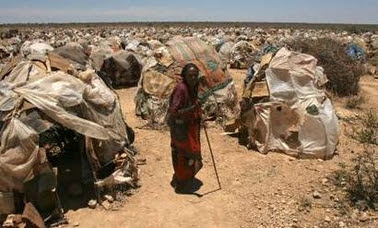Hey everyone, my name is Paola Cruz and I have to admit that when I first chose Somalia for my project I had never heard of it before, and probably neither have you. And guess what?? That's the main problem. Very few people know about this struggling country in Africa and those who know about it, ignore there problems completely. Now that I have come to know better this country I am truly glad I chose it. In the few weeks that I have researched about Somalia, this country has really grown on me and I have come to really care about what they are going through. It has opened my eyes, opened my world, has made me think very differently, and most importantly has made me appreciate more the things I have.
PEACE IN SOMALIA:
PEACE IN SOMALIA:
It is really sad to see this people just like you and me living in such inhumane, unsanitary, and poor conditions. NO HUMAN BEING should live this way.Something that really shocked me was that when I googled Somali pictures the results were all deaths, violence, wars, guns, sad faces, and skinny bony bodies. I really couldn't believe what I was seeing. All that came to my mind was: How can they live like this? Can a country really be in such bad conditions? and finally Where are the HAPPY photos? Do they even exist? Somalia is passing through one of the world's worst humanitarian crisis today, and yet very little help is given to them. One of their biggest problems has been their lack of no permanent government for 20 years. This has has made them suffer from not having all the human rights they deserve, they've been treated unfairly, cruelly, and have made their lives a living hell and a daily battle field. Each day Somalia experiences out of control violence and hundreds of deaths, but sadly this has all become natural to them. A normal day in a Somalis life is a constant struggle to survive. While we calmly go to our homes, find food at our tables, and sleep in our beds with air conditioners; Somali people struggle and worry if they can afford bread for their families, if they can find water, if they can find a place to sleep, or even their families are safe. I don't know about you but this has to STOP. People can't live like this.
Right now the news and other media communications only show one part of what is happening in Somalia. All they talk about is of how awful,violent, corrupt, and rebellious Somali people are. How Somali pirates are hijacking ships and stealing, how Somalia is always fighting and killing people. All they do is make them seem as the bad guys, but no help is given to them. But the question is, why do Somalis act this way? This question and the answer for it is never mentioned because it would implicate a lot of countries, high social leaders, inequality, and illegal things that would get into trouble many people. The truth of all of this is that Somali people have actually tried to protest peacefully, they have sent complaints to Human Rights, but what has happened? They have ignored them. An example of this was when many years ago private companies started to throw nuclear toxic wastes at Somali shores and nothing was done to stop them. Why? Don't they have the same rights as everyone? Things like this OBLIGATE Somalis to take matters into their own hands and do whatever they can to survive so they started to hijack ships for money. Can you really blame them? They didn't have too many choices and drastic problems call for drastic measures. All they were doing was finding a way to survive. They had also tried to agree with them that if they stopped throwing this toxic wastes they would also stop piracy, but like always they were ignored. Now why are they violent? They have tried to be peaceful but nothing changes. All they want is freedom and equality and all they are doing is fighting for it. It may not be the best way, but they felt they had no other options since their voices weren't heard. They kill and fight defending the only thing they have, their country. They have also lost their trust to other countries since the UN lied to them by saying they would help them when they really went to invade them.
Somalia can't change without our help, they can't do this alone. They have tried for years to better their conditions without any help but as you can see it hasn't worked. It is not going to be easy, but big things aren't easy. Every helping hand counts and can make a difference.We should start by trying to educate and reason with Somali people to make them vote for the type of government they would like, so they can finally have a stable permanent government. This will facilitate a lot of things for them like getting international protection and aid supplies. We should also try make a foundation for them and publicly speak the REAL TRUTH about them so that people can understand what they are going through. Sp please helpe create awareness because people need to understand they are the real victim's here. Once people know the truth they will start to complain and protest so that they can have the same rights as us. I also think countries that have hurt them the past years and have taken advantage of them should give them a certain amount of many for all the problems they have caused. It would also be very helpful if countries with good economies and stable governments would donate money and food supplies for them, instead of using it for unnecessary things.
























































